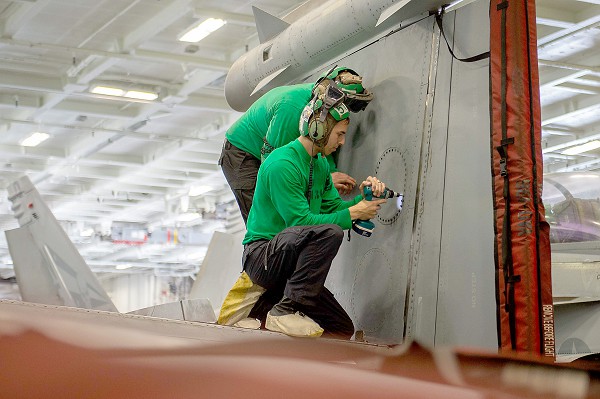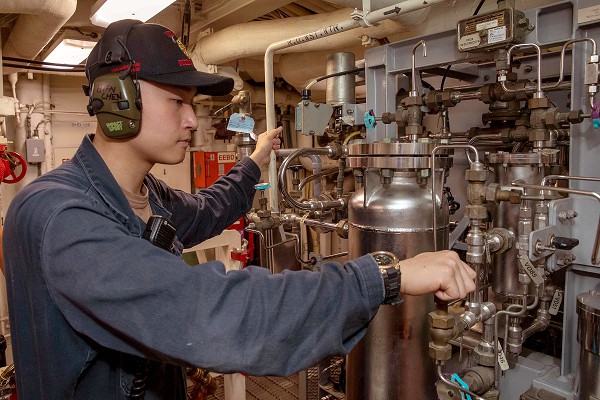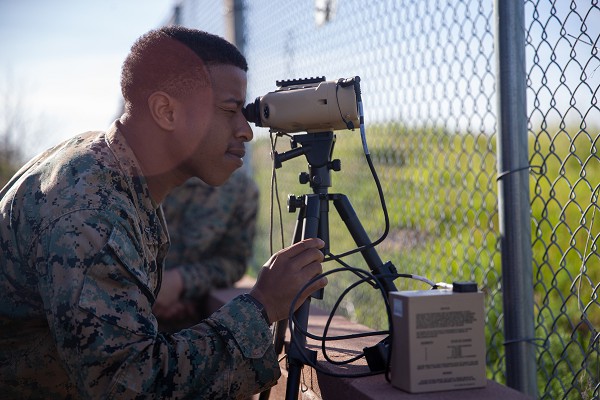- Details
- Hits: 560

Camp Pendleton, California. (April 5, 2023): In this photo by Sergeant Maximiliano Rosas, Corporal Benjamin McDonald, a bulk fuel specialist with Bulk Fuel Company, 7th Engineer Support Battalion, 1st Marine Logistics Group pumps excess seawater out of a liquid “bladder” during tactical operations on Silver Strand Beach, California.
Bulk Fuel Specialists install, operate, maintain, and repair fuel handling units and accessory equipment and test petroleum products used in amphibious assault vehicles. They are experts at hazardous materials management, and they test petroleum products to evaluate their quality. These professionals are responsible for refueling everything, from automobiles to jet aircraft, following strict safety protocols.
While the position of Bulk Fuel Specialists may not seem that glamorous, the mission they perform can easily decide the outcome of a battle. After all, what good is it for courageous Marines to seize a beachhead or liberate an airfield if you cannot get fuel, water, ammunition, and food to the troops and their vehicles. In fact, the 7th Engineer Support Battalion, also known as “Big Red”, has been so vital to military success that it has participated in the Viet Nam War, Operation Desert Shield/Storm, Operation Iraqi Freedom, and the war against terror in Afghanistan.
Today, Marine planners estimate that an expeditionary force would use 1.2 million gallons of fuel a day when conducting amphibious landings. Without experts at handling, storing, and distributing this precious commodity, even the finest military cannot succeed.
- Details
- Hits: 511

Hurlburt Field, Florida. (April 5, 2023): In this photo by Airman 1st Class Hussein Enaya, Airmen assigned to the 1st Special Operations Maintenance Squadron remove the rear spinner of an MC-130H Combat Talon II at the Squadron Central Repair Facility at Hurlburt Field, Florida. The Squadron is responsible for maintaining combat-capable aircraft and equipment for Air Force Special Operations Command missions.
Their motto, “Any Time, Any Place”, accurately describes the mission of these highly specialized teams of more than 650 active duty and civilian mechanics and engineers who service and repair a variety of special mission aircraft.
The Squadron operates a Centralized Repair Facility to address problems unique to Air Force Special Operations Command. These highly secretive missions require unique avionics, electronic warfare components, and flight controls. They also provide crash recovery and emergency response for the airfield and surrounding communities.
Read more: 1ST SPECIAL OPERATIONS MAINTENANCE SQUADRON “ANY TIME, ANY PLACE”
- Details
- Hits: 499

Pacific Ocean. (April 2, 2023): In this photo by MC3 Leon Vonguyen, Aviation Electronics Technician 2nd Class Garrett Fogg, from Augusta, Ga., conducts maintenance on an EA-18G Growler assigned to the “Gauntlets” of Electronic Attack Squadron 136 in the hangar bay aboard the Nimitz-class aircraft carrier USS Carl Vinson. The Carl Vinson is currently underway conducting Tailored Ship’s Training Availability/Final Evaluation Problem certification, a series of assessments of a crew’s ability to train themselves. When at sea, a carrier must make train its crew without any outside help. Crews are evaluated on their proficiency in warfighting, damage control including shipboard firefighting, simulated man overboard, abandon ship drills, and mass casualty events. Meanwhile, support units conduct replenishments-at-sea and do administrative reviews of crew performance.
Modern aircraft like the Growler are extremely complex and require great technical skill to maintain at peak efficiency. That is why one of the most vital Sailors onboard is the Aviation Electronics Technician. The ultimate jack-of-all-trades, these specialists are the consummate problem solvers, dashing between aircraft from tackling on issue after another. The aviation technician must know every aspect of the electrical systems on both fighters and helicopters, from engine wiring to navigation instruments, and be able to diagnose and fix problems “on the fly”. The job demands great attention to detail as these technicians work on flight-critical systems that impact passenger and crew safety.
- Details
- Hits: 726

Atlantic Ocean, (March 30, 2023): There are few things more terrifying to a Sailor than being marooned at sea, surrounded by water, dying of thirst. In the above photo by MC2 Cryton Vandiesal, Hull Maintenance Technician Fireman Wenwei Chen aligns a reverse osmosis demineralizer aboard the Arleigh Burke-class guided missile destroyer USS Nitze. The Nitze is part of the George H.W. Bush Carrier Strike Group that is on a scheduled deployment to Naval Forces Europe with the U.S. 6th Fleet.
The challenge of maintaining an adequate water supply at sea had bedeviled mariners for centuries. In primitive times, a captain would carry as much water as possible because, once out of sight of land, their lives depended on it. Landlubbers will ask, “Why didn’t they just boil sea water to drink?” The answer is simple, boiling seawater does not remove salt, too much of which is deadly for humans. Fortunately, today’s mariners have the technology to convert enormous amounts of saltwater into drinking water through a process known as distillation. Distillation is accomplished by heating seawater to the boiling point to vaporize it. The vapors condense into a liquid which removes impurities and contaminants.
The next step in generating fresh water aboard a warship is through Osmosis, a process to desalinate ocean water by passing it through a thin, porous membrane that acts as both a filter and a salt barrier. Reverse Osmosis requires multiple stages of filtration to strip off additional minerals and other solid contaminants. In the final filtration stage, essential minerals are added back into the water to ensure Sailors receive the potable nutrition from that is healthy to drink.
So, how does the Navy provide fresh water to ships as large as an aircraft carrier?
- Details
- Hits: 614

Charleston, North Carolina. (March 31, 2023): In this photo by Master Sergeant Matthew Plew, Airman 1st Class Natalie Vandergriff, an aerial combat camera journeyman, snaps actions photos during mobility force training missions over Charlotte, North Carolina. The 1st Combat Camera Squadron is the only active-duty combat camera unit in the Air Force that acquires imagery, both classified and not, for commanders and decision-makers in the field.
The Air Force Combat Camera Journeyman has played a courageous role recording military operations throughout the world. The images captured by these ordinary servicemembers have become some of the most iconic scenes of American at war. In addition to the deadly serious business of collecting classified information, the work of combat photographers helps shape both the image and public support for our nation’s military.
The story of the combat camera operators began during World War I when American Airmen flew some 35,000 hours capturing over 18,000 images of enemy positions. These primitive reconnaissance flights allowed American forces to “look over the horizon” to identify and target enemy formations, something that would prove vital to winning the war.
- Details
- Hits: 693

Camp Pendleton, California. (March 8, 2023): In this photo by Corporal Trent Holton, a transmissions system operator with the 9th Communications Battalion, 1st Marine Expeditionary Force Information Group, uses a laser range finder-integrated capability system during ANGLICO Base Course (ABC). Marines undergo six weeks of intensive training, divided into three phases, to become combat ready “Anglicans.”
For today’s Marines, gone are the bulky backpack radios that weighed troops down in the jungles of Viet Nam. Today, Marine Transmissions System Operators maintain the military’s signature communications tool, the Very Small Aperture Terminal-Expeditionary vehicular or man pack radio set. The TSO fields and maintains these powerful, lightweight radio sets with their antennas and power sources. In combat, a TSO establishes contact with distant stations, processes and logs messages, and conducts frequency changes or cryptographic codes in real time. TSOs train to use highly specialized hardware/software programs to establish communications networks anywhere in the world.
The ABC Course expands these student’s grasp of transportation, communications, and call-for-fire missions. Students learn how to coordinate fire support, conduct field radio operations, and how to direct air support. They also receive training in airborne operations, insertion methods, fieldcraft, and other infantry skills.


